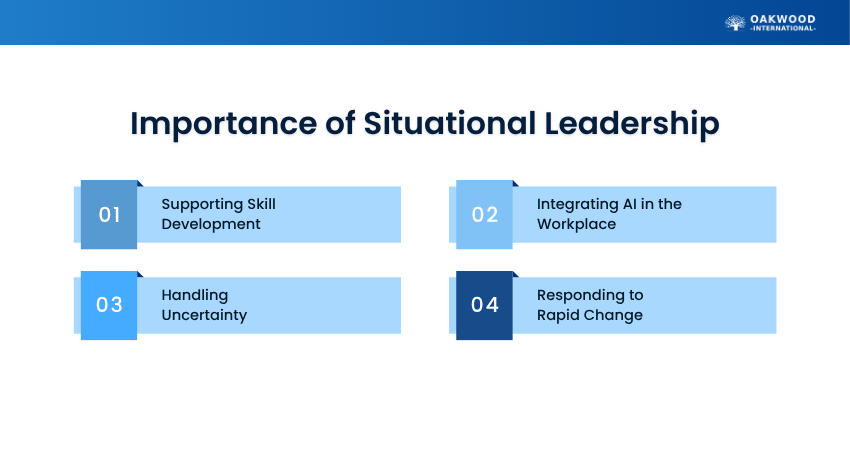Table of Contents


A workplace is a melting pot of different personalities, strengths and experience levels. As a leader, using the same approach for everyone can lead to confusion or slow progress. This is why Situational Leadership is vital to address this challenge. This is an adaptable style based on the teams' requirements at any given moment.
It encourages leaders to grasp the situation, understand their team members, and provide guidance accordingly. From beginners who need direction and guidance to experienced teams who need encouragement, this approach helps to respond in the right way. In this blog, you will learn about Situational Leadership in detail, its importance, practices, benefits and more. Keep reading to learn more!
What is Situational Leadership?
Situational Leadership is a flexible, adaptive leadership model that suggests there is no single best way to lead. Instead, effective leaders adjust their style based on the competence, confidence, and commitment of the individuals or teams they are managing. This model focuses on aligning leadership behaviour with the team’s development level for a given task.
This not only improves task performance but also creates trust, engagement, and long-term growth. The model is especially valuable in dynamic environments where team composition, goals or challenges frequently change, thus requiring leaders to stay responsive and adaptable in their approach.
Who Created Situational Leadership?
Situational Leadership was originally developed in the late 1960s by Dr. Paul Hersey, a management expert, and Ken Blanchard, a leadership consultant and author. Together, they introduced the model in their book "Management of Organisational Behaviour."
Hersey and Blanchard’s collaboration combined Behavioural Science with practical leadership strategies to create a model that emphasises adaptability and team development. Although they later developed separate versions, Hersey continued with the Situational Leadership® Model, while Blanchard introduced the SLII® Model.
Why is Situational Leadership Important?
Situational Leadership provides the flexibility to lead effectively in a wide range of scenarios, helping individuals and teams thrive regardless of complexity or change. Here are some of the reasons:

1) Supporting Skill Development
Situational Leadership enables leaders to tailor their approach based on an employee’s current skill level and confidence. A team member new to a task may need clear guidance, while someone more experienced may benefit from support or full autonomy.
2) Integrating AI in the Workplace
As AI tools reshape job roles and processes, employees face new learning curves. Situational Leadership allows managers to provide close guidance during early stages of AI adoption, gradually shifting to a more hands-off approach as competence grows.
3) Handling Uncertainty
Uncertainty, whether caused by market shifts, organisational changes, or global disruptions can leave teams feeling unsettled. Situational Leadership empowers leaders to offer the right balance of direction and support, depending on how ready the team is to handle ambiguity.
4) Responding to Rapid Change
Change is constant and accelerating. Situational Leadership allows leaders to shift gears quickly, aligning their leadership style with the current needs of the team. This flexible approach keeps teams agile, engaged, and ready to act without delay. It helps leaders to maintain stability during uncertainty.
Think you’ve got leadership potential? Let’s prove it with CMI Level 3 Award in Principles of Management and Leadership – Start now!
What are the Four Styles of Situational Leadership?
Each style is tailored to match an individual’s competence and commitment for a specific task, helping leaders provide the right balance of direction and support to drive performance and growth. Let's discuss for further details:

1) Directing (Telling) Style
This Situational Leadership style is used when team members have low competence but high commitment, often beginners or those new to a specific task. The leader provides clear instructions, close supervision, and defined roles. Decision-making is primarily with the leader, as the team member is not yet ready for autonomy.
Best for: New hires, trainees, or situations where accuracy and clarity are critical.
2) Coaching (Selling) Style
Applied when team members have some competence but may lack confidence or motivation. Leaders still provide direction but add more two-way communication and encouragement. They explain decisions and seek input to build buy-in and engagement.
Best For: Developing team members who need support to grow skills and motivation.
3) Supporting (Participating) Style
Used when team members are competent but may lack confidence or need motivation. Here, the leader offers less direction and more emotional support, encouraging participation in decision-making. The focus shifts from task instruction to motivation and collaboration.
Best For: Capable individuals needing a confidence boost or stronger team ownership.
4) Delegating Style
Ideal when team members are highly competent, confident, and committed. The leader steps back, allowing the individual or team to take full responsibility for decisions and execution. The leader's role becomes minimal, offering trust and autonomy.
Best For: Experienced, self-directed individuals or high-performing teams.
Key Responsibilities of Situational Leaders
Situational leaders take on a dynamic set of responsibilities to support team growth, adapt to changing needs, and drive performance through flexibility and awareness.
Assess Readiness: Evaluate team member’s skills, confidence, and motivation for each task.
Adapt Style: Shift between directing, coaching, supporting, and delegating as needed.
Guide Appropriately: Offer the right level of direction based on task complexity and experience.
Develop Skills: Support individual growth by adjusting leadership as competence increases.
Ensure Psychological Safety: Create a safe space for open communication and learning.
Monitor and Adjust: Continuously reassess and adapt leadership approach.
Encourage Accountability: Promote shared responsibility across the team.
Communicate Clearly: Tailor messages to team member’s needs and development levels.
Learn essential management skills with CMI Level 3 Certificate in Principles of Management and Leadership Training – Register today!
Benefits and Limitations of Situational Leadership
Situational Leadership like any leadership model, it also comes with certain limitations. The table below highlights the key benefits and challenges of using Situational Leadership:

Benefits
Situational Leadership offers a dynamic and responsive way to lead teams, helping leaders match their approach to the needs of individuals and specific situations.
1) Flexibility: Leaders can adapt their style based on the needs of individuals and situations, making it suitable for dynamic work environments.
2) Supports Team Development: By adjusting leadership behaviour, leaders help team members grow in competence and confidence over time.
3) Improved Communication: Tailored interactions based on each team member’s development level lead to clearer expectations and better alignment.
4) Encourages Autonomy: As individuals develop, leaders shift toward delegating, empowering team members and building trust.
5) Effective in Diverse Teams: Situational Leadership accommodates different working styles, personalities, and levels of experience within the same team.
6) Boosts Performance: Matching leadership to readiness leads to higher engagement, motivation, and productivity.
Grab your opportunities and lead the way with your CMI Level 3 Diploma in Principles of Management and Leadership – Sign up today!
Limitations
Despite its flexibility, Situational Leadership has certain challenges that may limit its effectiveness in some environments.
1) Requires Accurate Assessment: Leaders must accurately assess each team member’s competence and commitment, which can be subjective and time-consuming.
2) Can Be Inconsistent: Shifting styles frequently may confuse teams if not communicated effectively.
3) Heavily Dependent on Leader's Skill: Success depends on the leader’s ability to recognise development levels and apply the right style at the right time.
4) Less Effective Without Trust: If psychological safety or accountability is lacking, the approach may not yield results.
5) Not Ideal for All Situations: In highly regulated or urgent environments, adaptability may be limited, and a consistent approach may be preferred.
Best Practices for Effective Situational Leadership
To make Situational Leadership style truly effective, leaders must consciously balance direction and support, stay flexible in their approach, and maintain open lines of communication. The following best practices can help leaders excel in applying Situational Leadership in real-world settings.
1) Recognise the Balance Between Task and Relationship Behaviours
Strong situational leaders help in building trust and maintaining healthy working relationships. Too much focus on tasks can lead to burnout or disengagement, while overemphasis on relationships might slow progress.
By finding the right equilibrium, leaders can ensure productivity without sacrificing team morale, fostering a healthy and high-performing work environment.
2) Apply Varied Leadership Styles Based on the Situation
The strength of Situational Leadership lies in its flexibility. Leaders must be able to switch between directing, coaching, supporting, and delegating depending on team capability, confidence, and the urgency of the task.
For example, a new team member might benefit from a more directive style at first, while a seasoned professional might thrive under a delegative approach. Being able to adapt on the fly ensures that leadership remains relevant and effective.

3) Align your Leadership Approach with the Task at Hand
Situational leaders assess the scope, complexity, and importance of a task before deciding how involved they should be.
A high-stakes project with tight deadlines might need clear step-by-step guidance, while a routine task can be handed over with minimal oversight. This alignment prevents wasted effort and improves overall efficiency.
4) Prioritise Ongoing Leadership Training
The workplace is constantly evolving, and so should leadership skills. Continuous professional development. Leadership trainings, coaching, seminars, and industry networking equips leaders with fresh strategies and tools.
This commitment to learning not only sharpens decision-making and adaptability but also sets a positive example for team members. It encourages them to embrace growth and skill development as part of their own career journey.
5) Foster Open, Two-way Communication
Adaptability in leadership hinges on clear, open, and honest dialogue. Leaders who actively listen, seek feedback, and address concerns promptly create an atmosphere of trust and psychological safety.
Encouraging employees to share their perspectives ensures leaders have the insights needed to adjust their style effectively. Two-way communication also boosts transparency, reduces misunderstandings, and strengthens team cohesion.
Examples of Situations Where a Situational Leadership Style Works Best
Situational Leadership is most effective when the leaders morph their approach to match the performance readiness level of their team members. Different members require different levels of support and guidance. Here are some real-world situations where Situational Leadership style can work best:
1) Unable and Insecure or Unwilling
This situation often occurs with new hires, employees or interns learning a task for the first time. Since they lack essential skills and may be unsure about how to begin, a Directive Leadership Style is suitable. It is because it provides clear instructions and structured steps.
For example: A newly joined Customer Support Agent is asked to use a Customer Relationship Management (CRM) tool. They feel nervous and unsure where and how to begin. The leader steps in to show how it is done, demonstrating each step, and provides clear instructions.
What can help? Pairing them with experienced colleagues, offering guidance and giving them sufficient time to build their foundation.
2) Unable but Confident or Willing
Here, employees have some experience and confidence, but their skills are not strong enough to handle tasks independently. This requires Coaching Leadership Style. It involves involving them in decisions and helping them during problem-solving.
For example: A junior marketing executive understands basic campaign planning but struggles with high-level strategy. The leader coaches them, asks for their input, and guides them comprehensively.
What can help? Recognise their efforts, clarify expectations from them, and provide continuous support for development.
3) Able but Insecure or Unwilling
The employees under this level have strong technical expertise but hesitate due to lack of confidence, fear of failure or uncertainty. Here, Supporting Leadership Style can be employed for encouraging them, listening actively, and boosting their confidence.
For example: A highly skilled software developer is asked to lead a client meeting. They are worried about presenting. The leader steps in to reassure them, share their successes of the past and offer emotional support.
What can help? Reconnect them with their successful past works, highlight their strengths, and encourage small risks for building confidence in them.
4) Able, Confident, and Secure
These are confident and high-performing employees who excel in their roles and have strong ownership. This aligns well with the Delegating Leadership style for empowering them to work in an independent manner and have autonomy over decisions.
For example: A senior Project Manager who has successfully managed multiple projects is assigned a new one. The leader steps back and allows full autonomy to the employee, while aligning goals and deadlines.
What can help? Try sharing deeper organisational priorities and a long-term vision for helping them make informed decisions.
Conclusion
Situational Leadership is all about adapting your approach to fit the needs of your team and the task at hand. By balancing guidance and support, leaders can motivate their teams, improve performance, and handle challenges effectively. It’s a flexible style that works across industries, making leadership more responsive and results-driven.
Shape the future of your leadership - Secure your place with the CMI Level 3 Trainingtoday!


 Back
Back



 Back to Catagories
Back to Catagories





 + 44 7452 122728
+ 44 7452 122728










